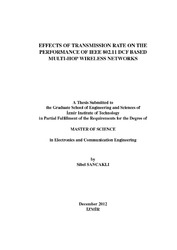Please use this identifier to cite or link to this item:
https://hdl.handle.net/11147/3553Full metadata record
| DC Field | Value | Language |
|---|---|---|
| dc.contributor.advisor | Aydoğdu, Canan | en |
| dc.contributor.author | Sancaklı, Sibel | - |
| dc.date.accessioned | 2014-07-22T13:51:47Z | - |
| dc.date.available | 2014-07-22T13:51:47Z | - |
| dc.date.issued | 2012 | en |
| dc.identifier.uri | http://hdl.handle.net/11147/3553 | - |
| dc.description | Thesis (Master)--Izmir Institute of Technology, Electronics and Communication Engineering, Izmir, 2012 | en |
| dc.description | Includes bibliographical references (leaves: 65-68) | en |
| dc.description | Text in English; Abstract: Turkish and English | en |
| dc.description | xi, 68 leaves | en |
| dc.description.abstract | Multi-hop wireless networks offer promising applications for future communications and they differ from widespread single-hop networks. Throughput (node-to-node successfully transmitted bits per second) is an important performance metric in single-hop wireless net- works, whereas goodput (end-to-end successfully delivered bits per second) becomes an indication of the performance in multi-hop networks. Energy-efficiency is another impor- tant performance metric due to the limited battery life of mobile devices. Main factors that affect the network performances are packet collisions that occur due to the hidden terminal problem and blocking of packets at interface queues at intermediate nodes in multi-hop networks. In this dissertation, the effect of transmission rate on goodput, throughput and energy performances of IEEE 802.11g DCF based on multi-hop wireless networks are in- vestigated over a large range of traffic loads. The performances are observed under direct transmission and multi-hop transmission, considering MAC contention such as binary ex- ponential backoff, retransmissions, collisions and overhearing of nodes. IEEE 802.11g DCF is used because it supports high data rates and has interoperability with the older version of IEEE standards. Network Simulator 2 is modified to compute the goodput, throughput and energy per bit (EPB) performance metrics under perfect channel condi- tions. The results reveal that varying the data rate has no effect on goodput, throughput and energy under light traffic loads. Under moderate-to-heavy traffic loads, goodput and energy efficiency performances drop sharply whereas throughput remains constant. Hid- den terminals and interface queue blocking is observed to be the reason for performance reduction of increasing goodput and EPB which increase with traffic load under moderate- to-heavy traffic loads. This suggests that a rate adaptation algorithm, which discriminates the reason of packet drops and keeps the transmission rate at the maximum can improve goodput and energy performances significantly for multi-hop wireless networks. | en |
| dc.language.iso | en | en_US |
| dc.publisher | Izmir Institute of Technology | en |
| dc.rights | info:eu-repo/semantics/openAccess | en_US |
| dc.subject.lcsh | Wireless communication systems | en |
| dc.title | Effects of transmission rate on the performance of IEEE 802.11 dcf based multi-hop wireless networks | en_US |
| dc.type | Master Thesis | en_US |
| dc.institutionauthor | Sancaklı, Sibel | - |
| dc.department | Thesis (Master)--İzmir Institute of Technology, Electrical and Electronics Engineering | en_US |
| dc.relation.publicationcategory | Tez | en_US |
| item.fulltext | With Fulltext | - |
| item.grantfulltext | open | - |
| item.languageiso639-1 | en | - |
| item.openairecristype | http://purl.org/coar/resource_type/c_18cf | - |
| item.cerifentitytype | Publications | - |
| item.openairetype | Master Thesis | - |
| Appears in Collections: | Master Degree / Yüksek Lisans Tezleri | |
Files in This Item:
| File | Description | Size | Format | |
|---|---|---|---|---|
| T001085.pdf | MasterThesis | 1.16 MB | Adobe PDF |  View/Open |
CORE Recommender
Page view(s)
98
checked on Nov 18, 2024
Download(s)
26
checked on Nov 18, 2024
Google ScholarTM
Check
Items in GCRIS Repository are protected by copyright, with all rights reserved, unless otherwise indicated.